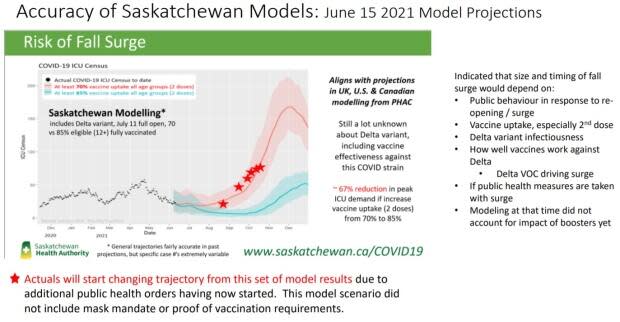Newly-shared Sask. COVID-19 modelling from June projected this fall's surge of ICU patients

Modelling provided to the Saskatchewan government last June by the Saskatchewan Health Authority (SHA) projected the fourth-wave COVID-19 hospitalization surge that is being experienced now in the province.
The four-month old projection was shared publicly for the first time last Thursday during a virtual town hall meant for SHA physicians. Recordings of those town halls, along with the slides shared, are typically published online the next day.
"They are remarkably accurate," said John Froh, a deputy chief medical officer at the SHA, of the predictions contained in the summer modelling.
Titled "Risk of fall surge" and dated June 15, 2021, the modelling projected the number of people who would be infected with COVID-19 and hospitalized in intensive care units ("ICU Census") on a daily basis from June to the end of 2021.
By mid-October, around 75 COVID-19 patients would be in ICU, the modelling suggested. In reality, 78 infected ICU patients were announced that day.
"I see comments, questions, 'How accurate is modelling? Modelling is just this or that or the other.' We really do have excellent modelling here," Froh said.
Froh pointed out how the red stars — which represent Saskatchewan's actual rolling seven-day average of COVID-19 ICU patients — closely align with what was projected back in June under one scenario (the red line).

The modelling took into account a number of factors:
The continuing spread of the delta variant.
The planned lifting of public health measures on July 11.
Two potential percentages of fully-vaccinated residents aged 12 and up: 70 per cent (the red line) versus 85 per cent (the blue line), though the province's reopening plan was predicated only on first-dose targets.
The modelling did not take into account the types of steps the Saskatchewan government later took to combat the fourth wave, including the announcement on Sept. 16 that mandatory public masking and a proof-of-vaccination program would soon take effect. Nor did the modelling take into account the eventual use of booster doses.
According to Froh's presentation, the fall surge predicted in the June 2021 modelling depended on factors such as the public's behaviour after the lifting of restrictions on July 11, second-dose vaccination uptake, how well the vaccines worked against the Delta variant and "if public health measures are taken [with] the surge."
After the public health measure were lifted on July 11, no new public health measure were announced for nearly two months until Sept. 10, when mandatory self-isolation for infected residents was reinforced, followed by the masking and proof-of-vaccine announcement on Sept. 16.
Out of the 817 COVID-9 deaths recorded in the province since the beginning of the pandemic, more than a quarter of them (244) took place since July 11, 2021.
On Monday, Premier Scott Moe reiterated his government should have acted sooner in implementing the measures announced on Sept. 16.
Calls for data's release date back weeks
Access to the province's COVID-19 modelling has been raised as an issue for weeks.
Last month, the Opposition Saskatchewan NDP called on the government to release the modelling that informed its decision to drop restrictions on July 11. That didn't happen.
By Sept. 24, Dr. Susan Shaw, the SHA's chief medical officer, told colleagues during a virtual town hall that week that although modelling was still being produced, the Ministry of Health had decided it should not be widely shared with doctors in the province.
The government did not comment on Shaw's remarks at the time.
Last Wednesday, the government released modelling dated Oct. 20 which suggested that the number of Saskatchewan residents infected with COVID-19 and placed under intensive care could more than double by the new year if no additional public health measures are brought in and if people don't change their behaviours in the next few weeks.
Chief Medical Health Officer Dr. Saqib Shahab broke down during a presentation of that modelling.
The next night, the slide revealing what the modelling had suggested back in June was shared with doctors during the latest town hall.
Like the more recent modelling released last week, the June modelling suggested that with no additional public health measures, the number of COVID-19 patients in ICUs would surge in the fall.

 Yahoo Finance
Yahoo Finance 